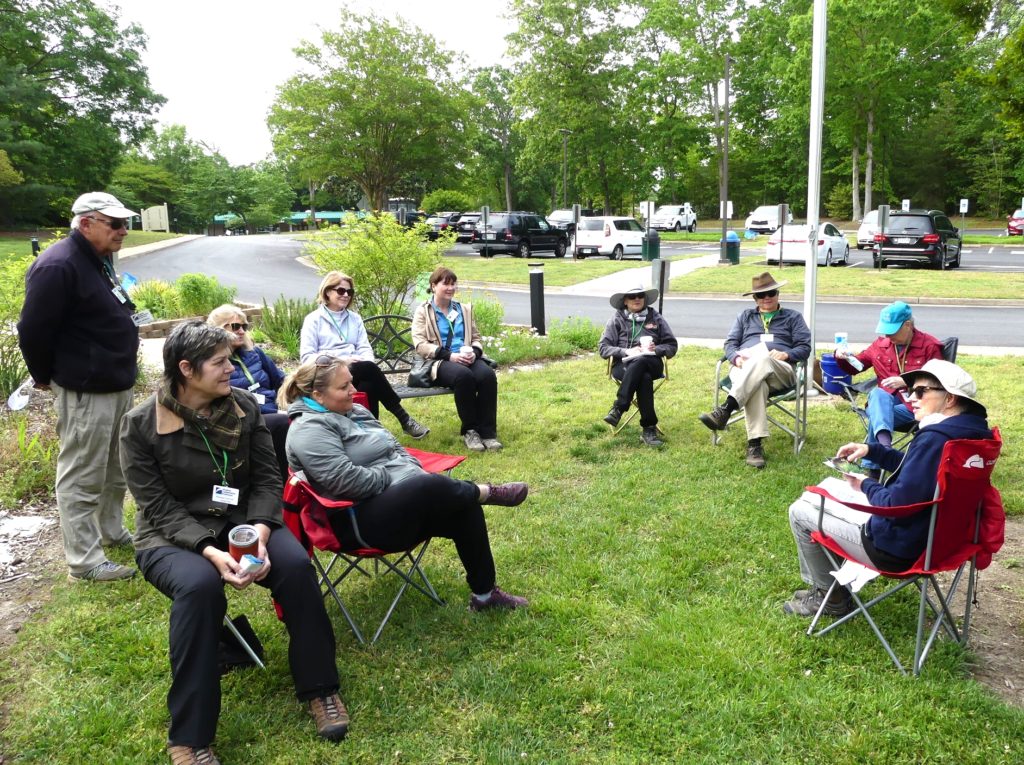Water-Wise Demonstration Project
by Elvin & Kay Clapp · Published · Updated
The Water-Wise Demonstration Project is located in front of the Human Services Center (HSC) at 5249 Olde Towne Road (shown here). About 10,500 people walk through this garden each year. They are generally families, often bilingual, seeking social services and affordable health services. Our water-wise garden provides a peaceful setting for them, showcasing a variety of drought-tolerant perennial plants in a low-maintenance, low-water setting.
This year we're reaching out in English and Spanish by posting what is blooming on a whiteboard with actual blooms next to plant names. We're also distributing “basic” Virginia Cooperative Extension handouts in both languages. The plant labeling project and brochure development are just starting. We are increasing the greeting, talking, and learning from visitors and staff as they walk through the garden. More children will come by this summer and we are planning handouts and activities for them as well. Overall, we strive to follow these basic water-wise principles.
Design for Water Efficiency: Thoughtful design is key, selecting mostly native plants known to thrive in local landscapes and grouped according to water needs. Together, they offer variety in bloom, fruit, foliage, and texture through the seasons.
This Water Wise Project began in 2004. We have been tweaking the garden to promote layering design and to increase the number of drought-tolerant native plants. We are also working with the building and grounds managers to install a rain barrel.
Improve the Soil: Soil is the foundation for healthy plants. Practices include taking soil samples, adding organic matter, sloping away from buildings, and adding bumps or swales to promote interest. Low moisture plants go on the swales and thirstier plants go on the bottom. Annual mulching over the years has built up the garden soil. We add amendments as we rework certain areas. Two retaining walls were added in 2018 for erosion control along the main walkway edges. Overall, the garden slope is gentle, leaving no standing water after significant rain. Downspout runoff from the large roof surface presents a challenge.

Evening primrose, Oenothera speciosa, showing an attractive bloom in May 2021. The team is reducing its footprint and educating the public about its’ aggressiveness.
Select the Right Plant: The garden is diverse with varying microclimates in terms of sun exposures, light intensities, wind conditions, and temperatures. Like a puzzle, the challenge is growing natives and non-natives that will thrive together. Currently, the garden mix is about 30% natives and our goal is to increase this to 70%. Taking baby steps, the team recently chose to rework the beds closest to the main entry. One area is almost complete with low-water species such as sedums, ice plants, and yuccas.
Choosing what to move to another spot in the garden or to permanently remove is challenging. Working as a team and sticking to the grand design is key. Some invasive species are “showy” and thus well-liked by the walk-through public. This affords an opportunity to educate them about best management practices in managing aggressive species.
Mulches and Ground Covers: Both work in retaining water, reducing evaporation, preventing weeds, moderating soil temperatures, and mitigating erosion. Mulches also provide a barrier to disease. Ground covers add visual variety through their foliage, bloom color, and texture.
We are constantly learning from the garden. While mulch is generally a good thing, this spring the iris performed poorly. A quick glance at the literature revealed some of our areas should not be mulched. This fall we will practice “know before you mulch.”
Appropriate Maintenance: Good planning and design should greatly reduce maintenance. The expectation is to use less water, less fertilizer, less pruning, and no pesticides. In reality, many gardens like ours are dynamic and sometimes have a mind of their own. Covid protocol affected maintenance capabilities. We began photographing all beds on a monthly basis in early 2020. This later confirmed that aggressive wild geranium, vinca, and evening primrose had overtaken many areas. Much human capital was spent on weeding in 2021 and early 2022. That took a toll on the gardening fun. Currently, we are trying organic weed control with a vinegar solution. The latest photos confirm about a 60% improvement in weed eradication at least when viewed from the surface.
To recruit new members, a special Master Gardener Intern orientation and work session was held on May 11, 2022.
Connect and Educate: During the re-design and maintenance phases, we consider the demographics of our garden viewers. Communication is a two-way street. When working in the garden, we speak with the HRC clients and staff. We share best management practices and learn from their experiences. Each session contains an internal education session for ourselves. Presently we are focusing on video training presentations by Elaine Mills and other Northern Virginia Master Gardeners addressing how to create well-layered landscapes.
Empower and Work as a Team. Have Fun: Good garden practices are only part of the equation to having a sustainable project. The other part is to work as a team, empower our members, and have fun. But the most rewarding thing is to hear people passing by and complimenting this garden and comparing it with their past experiences. Perhaps this is the genesis for the creation of more water-wise and visually-appealing gardens in the community.
Story and Photo Credit: Elvin and Kay Clapp, Project Leaders & Master Gardeners, Class of 2018
Resources:
Creating a Well-Layered Landscape – New in 2022! (mgnv.org) Northern Virginia Master Gardeners, One-hour Video Presentation by Elaine Mills;
Water-Smart Landscapes Start With WaterSense (epa.gov) Environmental Protection Agency, brochure, “Having a beautiful yard doesn’t have to mean using a lot of water or spending a lot of money.”
Garden & Landscape Design A list of Virginia Cooperative Extension Service Resources for Garden and Landscape Design



